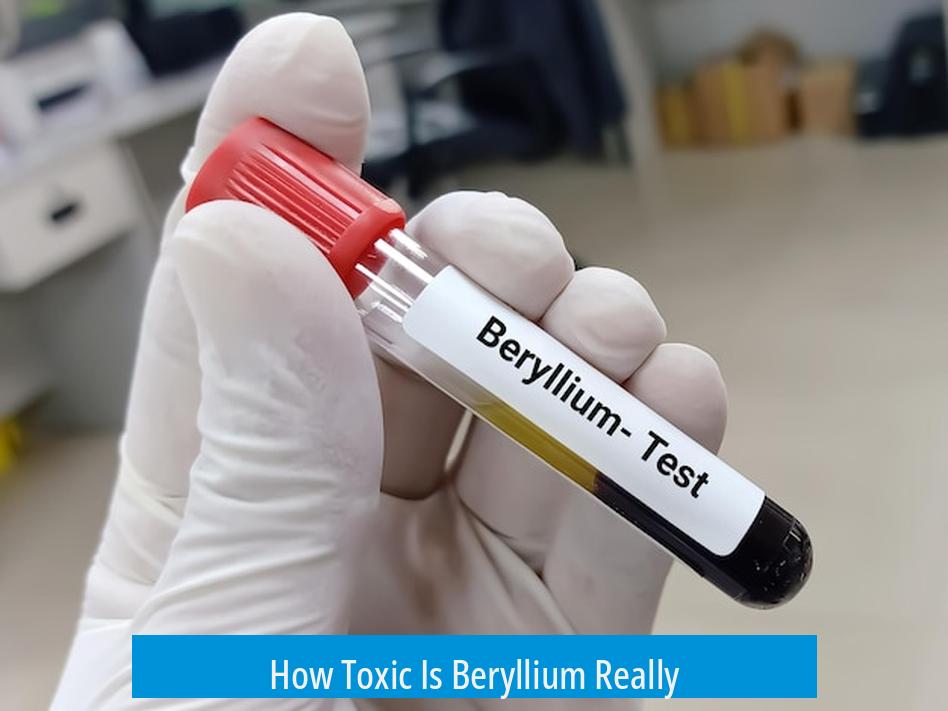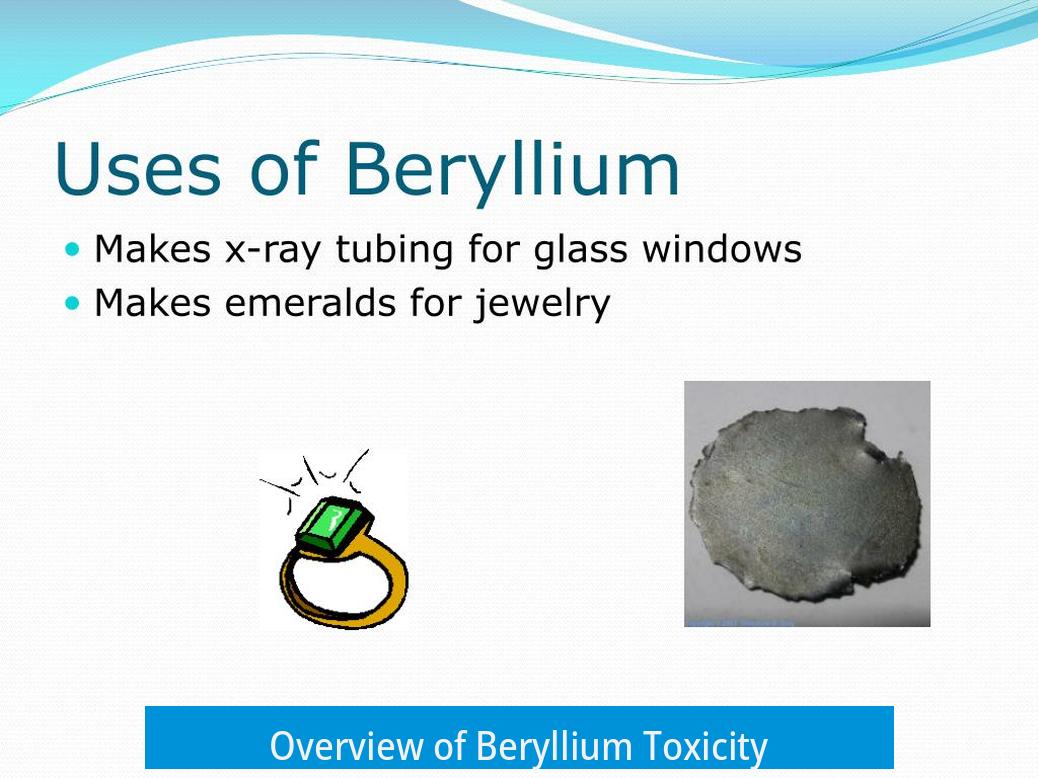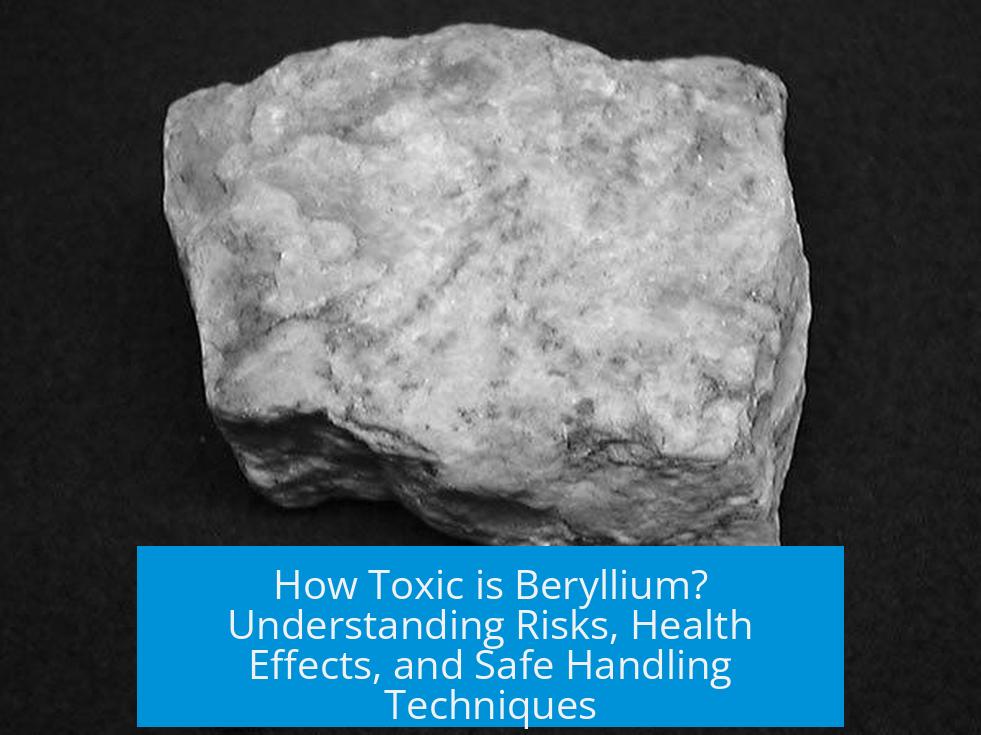How Toxic Is Beryllium Really?

Beryllium’s toxicity depends heavily on the form and route of exposure—while touching solid beryllium is relatively low risk, inhaling or ingesting its dust or compounds is highly dangerous. Inhalation of fine dust can cause severe lung diseases; therefore, stringent occupational controls are vital when handling beryllium materials.
Overview of Beryllium Toxicity

Beryllium is a lightweight metal used in aerospace, nuclear industries, and electronics. Its toxicity is unique compared to other heavy metals. Direct skin contact with solid beryllium poses mild risk similar to lead. However, tiny airborne particles and dust present a much greater threat. The Occupational Safety and Health Administration (OSHA) limits workplace air exposure to 0.2 micrograms per cubic meter, an extremely low threshold reflecting its potent toxicity.
Exposure risks increase primarily from inhaling dust or fumes created during machining, welding, or processing. Unprotected, chronic inhalation leads to serious health effects. Solid beryllium itself is stable and less hazardous, but its fine particles can penetrate lungs efficiently, causing progressive diseases.
Mechanisms of Toxicity
Beryllium ions (Be2+) chemically resemble magnesium. This allows beryllium to disrupt enzymatic processes by displacing magnesium in critical enzymes, impairing their function. It can infiltrate cells and accumulate in nuclei, blocking DNA synthesis and interfering with cellular replication.
The body cannot effectively eliminate beryllium once it enters tissues, resulting in prolonged retention and enhanced toxic effects. Around 35 micrograms of beryllium exist naturally in the human body without harm, but above this trace level, toxicity grows, especially from inhaled particles.
Berylliosis: The Primary Disease
The major health concern is chronic beryllium disease (CBD), or berylliosis, an incurable lung condition caused by immune sensitization to beryllium. The disease manifests as inflammation and scarring (fibrosis) of lung tissue, reducing respiratory function.
- Sensitization varies between individuals and may have a genetic basis, involving immune system differences that affect susceptibility.
- Reactions can occur even at very low dust concentrations, sometimes measured in picograms per liter of air.
- The disease causes lasting lung damage and can be fatal in severe cases.
Unlike acute poisoning, CBD develops over months or years of exposure. Acute beryllium poisoning is rare but severe. Hypersensitive individuals must avoid any exposure.
Comparisons to Other Toxic Metals
Beryllium ranks alongside lead in surface toxicity but exceeds it due to its fibrous dust nature, similar to asbestos. Unlike mercury, whose toxicity often arises from organic salts, beryllium’s inorganic dust particles cause immune-mediated lung disease.
Some chemists comment that beryllium is more dangerous to work with than lead or mercury because inhaled dust can cause permanent lung injuries. This complexity raises risks in settings where controls fail or personal protective equipment (PPE) is lacking.
Safe Handling and Exposure Controls
Machining or processing beryllium requires strict controls:
- Use wet machining to minimize dust dispersion.
- Operate in enclosed, ventilated environments with HEPA filtration.
- Wear appropriate PPE, including respirators and gloves.
- Clean workspaces thoroughly to eliminate residual particles.
- Follow OSHA exposure limits rigorously.
Minimal exposure during enclosed, controlled multi-week projects can be safe for non-hypersensitive individuals. However, uncontrolled dust exposure presents grave health and environmental hazards. Many professional chemists advise against unregulated home use due to these risks.
Historical and Industrial Context
Beryllium’s use dates back decades, especially in advanced physics experiments and aerospace. For example, the Lawrence Berkeley Lab fabricated complex beryllium components in the 1960s. Handling it was expensive and required specialized machine shops. Even experienced workers recommend washing hands extensively after contact.
Copper-beryllium alloys are prized for strength and conductivity, widely used in industry. Beryllium was historically present in fluorescent lamp phosphors and heat sinks. Its presence in gemstones like emeralds also sparks curiosity about potential exposure risks in crystal processing.
Health Effects Summary
| Exposure Type | Risk Level | Health Effect |
|---|---|---|
| Skin Contact (Solid) | Low | Minor irritation; safe with proper hygiene |
| Inhalation of Dust/Fumes | High | Chronic berylliosis, lung fibrosis, potential fatality |
| Ingestion | High | Potential systemic toxicity and organ damage |
Key Takeaways
- Beryllium is relatively safe on untouched solid surfaces but extremely toxic when inhaled or ingested as dust or fumes.
- Chemically, it disrupts enzymes by replacing magnesium and blocks DNA synthesis in cells.
- Chronic beryllium disease, a serious lung condition, can develop after prolonged exposure, with a genetic predisposition influencing outcome severity.
- Strict industrial hygiene, including wet machining, PPE, and air filtration, dramatically reduces exposure risks.
- OSHA exposure limits are set at very low levels (0.2 μg/m3) to prevent sensitization and lung damage.
- Chemists regard beryllium as more hazardous than other heavy metals when inhaled, underscoring the need for caution.
Is touching beryllium as dangerous as inhaling its dust?
Touching beryllium is less harmful than inhaling or ingesting it. Surface contact has toxicity close to lead, but inhaling dust can cause severe lung disease and long-term health issues.
Why is beryllium exposure tightly regulated by OSHA?
OSHA sets a very low limit of 0.2 micrograms per cubic meter due to beryllium’s ability to cause chronic lung disease even at tiny doses. The body cannot remove beryllium once exposed, increasing risk over time.
How does beryllium cause damage inside the human body?
Beryllium interferes with enzymes by displacing magnesium, targeting cell nuclei, and disrupting DNA synthesis. Its high charge and small size allow it to accumulate, causing lasting tissue damage.
Can genetic factors influence sensitivity to beryllium?
Yes. Some people have immune system mutations that make them highly sensitive. These individuals may develop chronic berylliosis after low-level exposures, while others might show fewer effects.
What safety measures are essential when machining beryllium?
Machining requires wet methods and enclosed spaces with proper PPE. Capturing all dust is critical. Unprotected, prolonged exposure to dust poses serious health and environmental hazards.





Leave a Comment